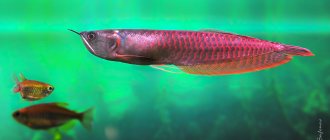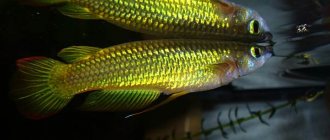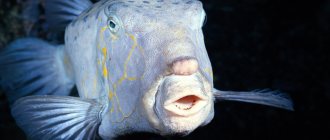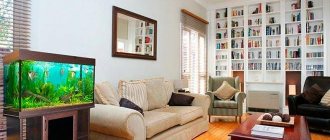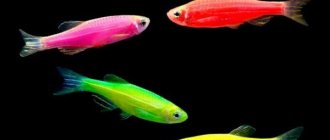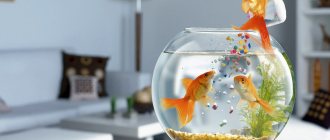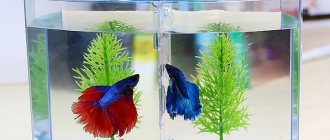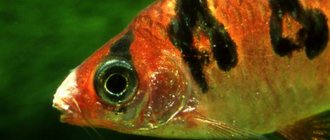Other types
Adding fish to the very first aquarium is one of the most important tasks of an aquarist who has just begun to delve into the topic and treats his activities with responsibility. There are a huge number of species of ornamental fish on sale. But many of them require specific conditions of maintenance, and a beginner in the aquarium business cannot always cope with caring for capricious creatures.
Before purchasing an aquarium and populating it with inhabitants, you should study information on microbiology, biology, and hydrochemistry. But even with certain knowledge, it is impossible to accumulate experience without mistakes. Sometimes an accidental mistake can lead to losses, and the most sensitive species are the first to die. But, there are species that are hardy. They are able to survive in less than favorable conditions and can exist in different ranges of water parameters.
Aquarium unpretentious fish do not require a special aquatic environment, and are also able to reproduce easily and quickly. For a novice aquarist, it is very important that the first experience of breeding and propagating fish becomes positive.
Unpretentious fish for an aquarium must have the following qualities.
- Affordable price.
- Peaceful disposition.
- They do not require special conditions.
- Endurance and vitality.
- A beginner aquarist should be able to handle fish.
The most unpretentious fish that can survive in small aquariums
Guppy
This species tops all ratings of convenient and easy-to-care fish. They are cheap and do not require special conditions. Almost all amateurs started with this species. Guppies are small in size and come in a wide variety of colors.
They are capable of not only surviving in extreme conditions, but also giving birth to fry.
The minimum size of a flock is one male and two females. You can put them in a tank with a volume of 20 liters, but 50 is better. They multiply and develop very quickly. After just a few months, the population will have a larger number of individuals than it originally had.
This species is viviparous, and newborn fry are able to swim and feed immediately after birth. The spawning process can take place in a community aquarium and does not require outside intervention from the owner.
They feed on good quality live, dry and frozen food.
Simple types of guppies are more hardy, relative to the selection ones.
Compatibility
Guppies are peaceful and can get along with everyone except those who can chew off their fins. After all, for a male, a veiled tail is the most important advantage.
Tetra
Tetras are fish from the characin family. Color and size depend on the species; Tetras usually reach 4-8 cm in length, and the colors include shades of red, gold, silver and yellow.
Tetras are kept in flocks of 6 or more individuals. When kept alone, they become inactive or, conversely, begin to show aggression towards other inhabitants of the aquarium. Tetras are mobile and can jump out of the water, so the container must be covered with a lid. Lighting is preferably dim, water temperature – 24-27°C, pH 6-7, dH up to 15°. Tetras swim in the middle layers of water, and prefer to take food from its surface.
Sticky catfish, or ancistrus
These are peace-loving fish with high levels of endurance. The main diet is algae. If there is vegetation in the aquarium, then catfish will help control its amount. It is important to ensure that the driftwood sticks, since all representatives of the species require cellulose.
Since ancistrus are phytophagous, the food should contain spirulina or other components of plant origin. Also, the fish will not refuse lettuce leaves, zucchini, cucumbers and other vegetables.
The minimum volume of the reservoir is 50 liters. Representatives of some varieties are quite large, growing on average up to 10 cm.
Since the catfish's body is covered with a dense bony shell and spines in strategic places, representatives of the species feel good even where cichlids live.
Compatibility
Ancistrus are inactive and often sit in shelters. But sometimes they can show aggression and attack neighbors. For this reason, it is not worth keeping them in the same container with rare species of fish that are not able to defend themselves or quickly escape.
Lyalius
Lyalius is a peaceful and shy labyrinth fish. Lalius are kept in pairs or small groups in containers planted with plants at a water temperature of 22-27°C, pH 6.5-7 and dH up to 20°. It is necessary to monitor the level of nitrogen compounds and prevent it from increasing. When the temperature drops, as well as stress, lalius can get sick.
Males of Lalius are characterized by intraspecific aggression, so keeping 2 or more males together is possible only in large quantities and if there are a sufficient number of females. Lalius do not show aggression towards representatives of other species. Lalius should not be kept together with lively fish (for example, barbs, cichlids), which can tear off their delicate fins.
Sumatran barbs
These are schooling fish with high activity. They are appreciated for their interesting behavior. But when purchasing, it is worth considering that barbs do not always get along with other species. If the reservoir already has inhabitants that are weakly mobile and have veiled tails, then you should discard the barbs, or place the fish in a separate aquarium.
They prefer to lead a gregarious lifestyle and stay close to the bottom of the reservoir. Males often organize fights among themselves, trying to attract the attention of the female. But don’t be afraid that the fish will injure each other. Within a few minutes after the fight, they can calmly swim in the aquarium.
To keep barbs, you should plant the aquarium densely with plants and put dark soil on the bottom, otherwise the colors will become pale. A school can contain from 5 to 10 fish. Reservoir volume up to 50 liters.
Compatibility
Barbs are not predators, but the fry that appear in sight are swallowed instantly. Neighbors in the aquarium should have similar sizes. They can be kept with fish of other species if they are active and able to defend their interests.
Neon
Neons are small, schooling aquarium fish with spectacular colors: along their sides there is a stripe of greenish-blue color that can reflect light. Thanks to this property, the fish seem to glow in the dark; This is how they got their name. Neons look especially advantageous against the backdrop of dense greenery in dim lighting.
Neons are kept in flocks of 6 or more. When kept alone or in pairs, fish experience stress, which shortens their lifespan. In an aquarium, neons stay in the middle and lower layers of water and never rise to the surface. In this regard, they should be fed with food floating in the water column.
Parrot
This type of fish is not found in nature, as it was bred artificially. The basis of selection is American cichlids.
Representatives of the species are distinguished by a large body and a bow-shaped mouth. These are large and colorful fish that do not require special care. The only thing they require is a spacious aquarium, the volume of which exceeds 200 liters. In favorable conditions, representatives of the species reach 25-30 cm.
Feed in small portions several times a day. They have a tendency towards obesity. There are special foods developed for this species.
Despite the fact that the fish pair up and exhibit mating behavior, the males of the hybrid are sterile. In rare cases, eggs can be fertilized by closely related species, but even if the offspring are viable, they do not resemble the parents in appearance.
Compatibility
Can be housed with similar species, such as cichlids. If there are small fish in the pond, the parrots will perceive them as food. The red parrot is generally peaceful in nature, but some individuals can bully other fish. Also, aggression increases during the spawning period.
Labyrinthine
The labyrinthine group includes fish that have a special body structure and require atmospheric air. Widely known are lalius, macropods, cockerels and gourami.
Gourami
Cockerels
Beautiful labyrinth fish with an exquisite appearance. Cockerels show their fighting qualities mainly with their relatives, but they get along quite well with others. The fish are undemanding in care, but love clean water.
Gourami
Gourami have the amazing ability to breathe atmospheric air thanks to the epibranchial organ. Marbled gouramis were bred by breeders by crossing blue and spotted species. Gouramis move slowly and majestically, watching their calming movements will calm their owner after a busy day.
Return to content
sword bearer
These are picky viviparous fish, easy to care for and easy to reproduce. The main feature of the species is the elongated ray of the caudal fin. In shape it resembles a sword, and this is what served as the basis for this species name.
The classic color option is a red body, black color and a single tail beam. But now many breeds have been bred that differ not only in color, but also in the number and shape of swords.
The swordtail's body has an interesting feature - under certain conditions, the female can change sex to the opposite.
Under natural conditions, they prefer to live in thickets, for this reason it is important to create the same environment in an artificial reservoir. It is also important to put natural driftwood on the bottom. It is there that unicellular algae develop, which can supplement the diet of swordtails.
If several males live in an aquarium, then shelters should be organized to avoid conflicts between them.
The character is peaceful, swordtails rarely cause disturbance to other inhabitants of the aquarium. But this is only possible if you select the right fish based on gender and age. It is also important to place swordtails in a large enough aquarium.
If there is a flock of barbs in a reservoir, then there will always be a strict hierarchy in it. It should consist of one male and several females. There can be several boys, but no more than three per aquarium.
Compatibility
Can be kept with all fish of similar sizes. These can be dani, platies, angelfish, barbs. Avoid proximity to cockerels and other fish with veil fins. The ban also applies to large aggressive predators.
Pecilia
Platies are small viviparous fish. They are unpretentious and able to adapt to different conditions, but they prefer water with a temperature of 24-27°C, pH 7.5-8 and dH 8-25°. Platies do not like excess nitrogen compounds, so the aquarium must have good filtration.
They keep platies in groups with a predominance of females. Almost any non-predatory aquarium fish of similar size will be suitable as neighbors. Since platies do not like soft and acidic water, neighbors are selected for them based on their requirements for these parameters.
Gourami
Simple and unpretentious in content. Endurance and high rates of adaptation allow it to adapt to unfavorable conditions, even if a novice aquarist makes mistakes, for example, does not purify the water in a timely manner.
All representatives of the species have a labyrinthine organ - these are peculiar lungs that consist of thin plates of bone tissue. The organ has a large number of capillaries and is covered with protective mucus. If there is insufficient oxygen concentration in the water, the fish floats to the surface and breathes air.
The labyrinth organ increases stamina, and the fish can survive even if the aquarium is half empty. But it is important to provide the gourami with access to air. To avoid sharp temperature contrasts, it is necessary to cover the aquarium with a lid. Thanks to this, moist and warm air is formed above the surface of the water, and the labyrinthine organ will not be endangered.
Compatibility
Most often, several different species of gourami are settled in one body of water. They look good together. But it should be borne in mind that males jealously guard their territory and often fight among themselves. To avoid conflicts, the behavior of the fish should be monitored for the first time after planting.
It is not worth housing with barbs or swordtails, since gouramis may lose their fins. If there are ampullaria snails in the reservoir, then the gourami eats small individuals, bites off the antennae of adult snails and does not allow them to the surface to breathe air. You cannot live with cichlids, parrots, or goldfish.
Large species
Most large fish are predators, characterized by intraspecific and interspecific aggression and territorial behavior. However, there are a number of large, peaceful aquarium fish that are suitable for the community aquarium. Among them are the following types:
- Angelfish. Quite unpretentious, prefers soft and slightly acidic water. A predator, therefore it will eat fry and small neighbors. Not suitable for keeping together with barbs and other active species that can pluck the fins of angelfish.
- Discus. Heat-loving, slow-moving, stress- and disease-prone cichlid. Not suitable for beginners. Not compatible with mobile and aggressive species.
- Aulonocara. Peaceful, brightly colored cichlids that get along well with similarly sized cichlids that prefer hard water.
Danio
These are the first genetically modified creatures. Thanks to the implanted fluorescent gene, the body of the fish has a bright coloring. Under natural conditions, representatives of the species reach 7 cm, but in an aquarium they do not exceed 4.5 cm. All artificially bred variations are tenacious, since they have retained the endurance of their original form.
These are schooling fish and need a reservoir with a capacity of 50 liters or more. All representatives of the species love to jump, so a mandatory element of the aquarium is a lid. Not only dark sand should be placed on the bottom, but also driftwood or other decorations so that some individuals have the opportunity to hide.
There must be at least 6 individuals in a school, otherwise the fish experience severe stress. Under this condition, the zebrafish will begin to get sick and quickly die.
It is better to fill the aquarium with plants, but it is necessary to leave a place where the zebrafish can play and eat.
Representatives of the species quickly adapt to smooth changes in water parameters, but in nature they live in reservoirs that are filled with clean, oxygen-rich water. It is important to organize aeration (for the dark), install a filter and create a moderate flow.
Compatibility
Peace-loving fish that can be successfully combined with other species in a common aquarium. They create their own flock and constantly play with each other. Danios are not prone to attacking representatives of other species. They go well with tetras, minors, rasboras, neons, thorns. You should not place them with cichlids and other predators, since zebrafish will become the object of hunting for larger fish.
Angelfish
Angelfish are beautiful, peaceful cichlids. Their body is flattened laterally, and the fins are elongated, due to which the fish is shaped like a crescent. Natural coloring is silver with vertical black stripes; breeders have bred angelfish of black, white, marbled and other colors.
It is better to keep angelfish in a group of 6 or more individuals; required volume – from 100 liters per couple. Having reached sexual maturity, the fish split into pairs. One pair dominates the flock, but angelfish do not engage in serious fights. In an aquarium, these fish move in all layers of water, preferring to stay in the upper half of the volume.
Ternetia
An ideal pet to introduce you to the world of aquarium keeping. They get along well with other species, are not picky about conditions and live a long time. There are several breeding forms available for sale. The only condition that is important to ensure is that the water temperature in the aquarium must be at least +28 C0.
The minimum volume is 50 liters. There should be at least 8-10 fish in a school. A lid is required. Thorns also love dense vegetation.
There should be driftwood of natural origin at the bottom.
Under natural conditions, the basis of the diet is larvae or insects. For this reason, it is important to provide fish with high protein food.
Compatibility
If there is a flock of 8-10 fish in the aquarium, then the thorns will focus only on themselves, and simply will not pay attention to other inhabitants. But it is better not to choose slow fish with lush veil fins, since the thorns will bite. Also, you should not experiment with fry and small fish - they will eat you. They get along well with catfish, mollies, swordtails, zebrafish, angelfish, and gouramis.
What is preferable for beginner aquarists?
Not all existing phenotypes are suitable for beginner aquarists. Therefore, when selecting, they are guided by several rules:
- To fill the tanks, it is initially better to use swordtails and mollies. After all, caring for such individuals is quite simple.
- Guppies are also suitable for beginner aquarists. But such phenotypes are difficult to transfer into a common reservoir because it takes time to adapt. Therefore, the simplest subtypes are used for filling.
- For a classic tank, which has a round shape, a goldfish is suitable. Its characteristic feature is veil fins. Therefore, it is not worth introducing this phenotype with fish that consume algae. After all, they can disrupt the integrity of the fins.
- For those beginner aquarists who prefer active inhabitants, the zebrafish is suitable. Such individuals are distinguished by their bright colors, activity and peacefulness.
- Angelfish, whose bright colors attract and fascinate, are suitable for populating flat aquariums.
- Gours and cockerels are suitable for those citizens who are often absent for 2-3 days. After all, such fish tolerate water with a certain amount of organic matter. Catfish, which destroy algae and organic residues, are suitable for cleaning tanks.
To fill a new aquarium, you should not use all of the above phenotypes. Each fish undergoes adaptation. And this process takes varying amounts of time. Therefore, it is necessary to monitor the condition of the fish.
Video about peaceful little aquarium fish
AdminAuthor of the article
Did you like the article?
Share with your friends:
Mollies
These are inexpensive and easy to care for fish. They are viviparous. The fry are born fully formed and ready for independent life.
Kept in small flocks of 7 to 10 individuals. Minimum volume from 50 liters. They love to jump, so it is important to cover the aquarium with a lid.
Pebbles of the middle fraction are placed at the bottom. It is also important to organize small shelters for females who are not ready to breed.
Mollies love live plants, often eat the lower parts of algae, and scrape vegetation from all surfaces of the aquarium.
If there is a need to maintain a pure breed line, then you should not put different types of mollies in the same container - they have a tendency to crossbreed.
Compatibility
Peace-loving fish that do not come into conflict with other species. It is better to keep them in small flocks, in which females predominate. Neighbors must match in size. You can stock zebrafish, ancistrus, corydoras, and rasboras. They get along with all barbs except the velifer - they can bite their fins.
They do not get along with cichlids, even if they are large individuals.
The best aquarium catfish
Catfish are one of the most popular inhabitants of aquariums. In addition to a wide variety of species and unpretentiousness in breeding, these fish are also useful: they clean the bottom and walls of the home, eat leftover food and prevent plants from growing excessively.
Synodontis - catfish for a large aquarium
5
★★★★★
editorial assessment
100%
buyers recommend this product
See review▶
Synodontis catfish are also called changelings or cuckoos. Their body size ranges from 10 to 30 cm depending on the variety and size of the aquarium. The main features that unite all skinwalkers are a large scaleless body, laterally compressed, and a color with dark spots. Catfish spend most of their time at the bottom or on the very surface of the water, where they swim with their belly up. With proper care, catfish live up to 15 years.
Due to their large size, synodontis should be placed in large aquariums. One individual needs at least 50 liters of water. For a comfortable existence, they also need snags, thickets or other shelters where the fish can hide. Comfortable water temperature for this species is 23-28 degrees. Catfish prefer to live in schools of 4-6 individuals. Synodontis eats everything that gets into the aquarium, so it is not recommended to stock it with small fish - the catfish can snack on them in search of food. It is friendly towards large species.
Pros:
- lives up to 15 years;
- undemanding to water quality and temperature;
- thoroughly cleans the soil and walls of the aquarium;
- can be housed with most other fish species;
- not picky about food.
Minuses:
- not suitable for small aquariums.
Changelings love to dig the soil, so all plants need to be firmly supported. They also often raise turbidity from the bottom, which only a powerful filter can remove.
Pangasius is the most unusual catfish for large aquariums
4.9
★★★★★
editorial assessment
95%
buyers recommend this product
See review▶
Pangasius is a large fish, resembling a shark in shape and color, which is why it received its second name - shark catfish. In nature it reaches 130 cm, in aquariums it sometimes grows to 100 cm. The species is a long-liver and pleases its owners for up to 20 years.
Pangasius does not need special care. The main condition for its comfort is a reservoir with a volume of at least 1200 liters. The catfish cohabits peacefully with all the fish that it cannot eat. It is not recommended to house it with small species. Pangasius can live in almost any water, as long as it is clean.
Pros:
- unusual appearance;
- lives up to 20 years;
- peaceful character;
- undemanding to water parameters;
- easy care.
Minuses:
- difficult to find on sale;
- eats small fish;
- you need a very large aquarium.
Catfish have delicate skin, so the soil and decorations in the aquarium must be carefully selected, checking that there are no sharp corners that could injure the pangasius.
Pterygoplicht brocade - the most beautiful catfish
4.9
★★★★★
editorial assessment
90%
buyers recommend this product
See review▶
Pterygoplicht brocade is a leopard-print catfish. Its body is covered with small dark spots, and a beautiful fluffy fin up to 15 cm high rises on top. This is a fairly large fish - its body length can reach 50 cm, so it is not advisable to put it in small aquariums. It eats algae in large quantities, thanks to which a couple of such catfish can keep large bodies of water clean. Pterygoplichthus is a real long-liver. In nature, it lives up to 20 years, in aquariums - on average 10-15 years.
Catfish easily get along with any fish, are not aggressive, but at night they can eat the scales of flat fish. Angelfish, discus and other slow fish are not the best companions for him. Caring for a catfish is not difficult - you just need to feed it and clean the aquarium on time. For such a large pet, it is better to install a high-quality filter. Recommended water temperature is from 24 to 30 degrees.
Pros:
- effectively cleans the aquarium;
- long-lived;
- not aggressive;
- beautiful view;
- easy care.
Minuses:
- Suitable for large aquariums only;
- eats the scales of some fish.
Pterygoplichtha brocade is sold when it is still small, and it grows quite slowly. This can be confusing for an inexperienced aquarist. However, sooner or later the catfish will grow out of a small body of water. The ideal aquarium volume for it should be at least 400 liters.
Tarakatum is the best aquarium cleaner
4.9
★★★★★
editorial assessment
89%
buyers recommend this product
See review▶
Tarakatum catfish is a frequent inhabitant of small aquariums. Its laterally flattened body reaches a length of 10-14 cm. The color is from light brown to brown with dark spots. Like all catfish, it is nocturnal, inactive during the day and prefers to hide under snags or in plants. He shows no interest in other fish, regardless of their size. The main thing is that they do not invade its bottom territory.
In nature, cockroaches live for about 5-6 years, but in aquariums with proper care - up to 10. It is recommended to keep several of these catfish - they prefer to live in flocks. For catfish, aquariums with a spacious, wide bottom and an abundance of plants that create dark, secluded areas are ideal.
Pros:
- peaceful;
- suitable for small aquariums;
- lives up to 10 years;
- thoroughly cleans the bottom.
Minuses:
- does not get along with other bottom fish.
An aquarium with a cockroach must be covered with a lid, since there are frequent cases of them jumping out of the water. The soil should be smooth and not too shallow. If it is selected incorrectly, the catfish's whiskers may fall off.
READ ALSO
9 Best Aquarium Lamps
Corydoras Panda (other Corydoras too)
Mobile fish that prefer to live in small schools of 3-5 individuals can be kept in an aquarium of 20 liters or more. Capable of swallowing air. Due to the need for intestinal respiration, it is necessary to provide a supply of fresh air. There should be a layer of air under the lid, but it is better not to close the lid tightly so that there is a slight draft.
Compatibility
They get along well with neons, platies, and other types of armored catfish.
To increase the lifespan of aquarium inhabitants, you should take into account the compatibility of fish with other species, provide a favorable habitat, proper care and control the population of the aquarium. It is the latter factor that affects life expectancy.
The larger the aquarium, the easier it is to care for and the easier it is to create an ecological system capable of self-healing.
general information
Experienced aquarists advise starting your journey by choosing unpretentious fish species for several reasons. Aquarium keeping is a very multifaceted hobby, which requires certain knowledge of biology, hydrochemistry, microbiology, etc. The process of gaining experience, unfortunately, is not without mistakes. Some of these mistakes can lead to fish deaths, and the most sensitive species will die first. Hardier fish are more likely to survive local “cataclysms.”
It is worth noting that there are successfully aquarium fish for beginner aquarists in a wide range of water parameters, so you do not need to create a special aquatic environment for them, the main thing is to follow a few simple rules.
Also, unpretentious aquarium fish are usually quite easy to breed, which allows you to get the first positive experience in reproduction and understand its basic patterns, as well as replenish the population of your pets.
We bring to your attention the top 10 most unpretentious species that are perfect as your first aquarium pets.
Aquarium care
Weekly care for a 100 liter aquarium consists of replacing a third of the volume with fresh water, cleaning the glass from plaque and surface siphoning the soil. General cleaning is performed once every 1-2 months or less often, depending on the condition of the reservoir. During this process, all layers of the substrate are siphoned, algae and decorations are cleared of algae, the filter is washed, and the plants are thinned and trimmed.
Experienced aquarists often recommend that beginners purchase 100-liter tanks as their first aquarium. It is easy to establish and maintain biological balance in them, including due to the possibility of placing the necessary equipment. In addition, this volume is suitable for creating a multi-species aquarium, as it can accommodate schools of fish of different species.
If you liked the article or have something to add, leave your comments.
What kind of unpretentious fish are they?
@ lmxma pixabay.com
If you immediately purchase expensive, but very capricious aquarium fish, you may be completely disappointed. Often such specimens die, and the beginner simply cannot understand why this happened, because he did all the rules.
Aquarium keeping can be considered the most difficult hobby. At first, it is better not to complicate the howling path and purchase the easiest to care for, inexpensive fish.
Let's figure out which fish can be considered unpretentious:
- Individuals should not have special requirements for living conditions.
- The price of copies should be low.
- Small, can live in a small aquarium.
- They are peaceful.
Experienced aquarists do not advise waiting for quick results. In this case, the fish will quickly disappoint. They grow slowly and sometimes die, despite the creation of suitable conditions. Just admire their beauty and try to create a comfortable environment for them.
A beginner should not invest much in his hobby. Some people, after six months or a year, begin to understand that fish are not their pets. For starters, a small aquarium, 30-50 liters with simple equipment, is suitable. The cost is about 2000 rubles, including inexpensive fish.
Where to install?
The aquarium must be placed in such a way that it is naturally lit, but not exposed to direct rays. The place should be reliable and stable, but still allow you to easily carry out general cleaning, change the water, or feed your pets. A good place is the side opposite the window opening. It will be good if there is a socket nearby for connecting existing equipment: a filter, a heater, a compressor and the same lamp.
For safety, the level of the sockets should be higher than the level of the aquarium itself, since water ingress can cause burnt electrical wiring.
Easy access to water is also a plus, as it greatly simplifies the water change procedure. You should not place the tank near a TV or computer, as fish do not react well to noise.
Decorating a 100-liter aquarium
The design of a 100 liter aquarium can be interesting and original. The large volume provides freedom for creativity and allows the use of large natural or artificial decorations in the design.
Using stones, cork bark, polystyrene foam, polystyrene foam, polystyrene foam and other materials, creative aquarists can create a three-dimensional background. The recesses in it are suitable for planting plants, and the built-in air spray will create a beautiful curtain of bubbles. At the same time, it is necessary to remember about the safety of the materials used for aquarium inhabitants.
Instead of a volumetric background, you can use a film with an image of the underwater world, which is glued to the outside back wall. A correctly selected image will help to visually increase the volume of the vessel or add greenery to an aquarium without living plants.
Soil is poured onto the bottom of the reservoir and decorations are installed: stones, driftwood or artificial decorative items (ships, chests, etc.). In order for the aquarium to look harmonious, it is important to decorate it in the same style and not overload it with various objects. The fish should have enough free space to swim.
How to equip?
Setting up an aquarium is impossible without a high-quality internal filter, which costs approximately 1,200 rubles. To save money, it can also be used for aeration, but it is much better to immediately purchase a compressor. In addition, a 100-liter tank will require high-quality lighting. For a classic rectangular aquarium, you need two T8 lamps of 18 watts each. The lamp is designed using incandescent, halogen, fluorescent or metal halide lamps.
Each variety has its own pros and cons.
Light can also be produced using LED lamps, but only as additional lighting or night lighting, since their power is quite low. The number of lamps should be calculated correctly, taking into account the needs of not only the fish, but also mainly the plants growing in the tank. When selecting light bulbs, it is important to monitor the level to which the water is drawn so that problems do not arise.
Choosing an aquarium and installation location
The artificial pond must be placed on a flat and stable base (for example, a special aquarium stand). Avoid exposing it to direct sunlight and cold air currents. The aquarium is placed at such a height that it is convenient to maintain. There should be an outlet nearby to connect the necessary equipment.
The choice of aquarium shape depends on its purpose and intended installation location. The best option for keeping fish is considered to be a horizontally oriented, narrow, rectangular tank with smooth walls. The dimensions of a 100 liter aquarium of this configuration are usually 75x45x30 cm (LxHxW). To keep plants, you can choose a wider tank.
Panoramic aquariums with a curved front wall can look original in the interior of the room, but it is difficult to observe the life of the underwater world in such a container due to the distortion of shapes. In addition, curved glass is inconvenient to clean from plaque.
Corner aquariums take up less space than other tank shapes and fit well into the interior, but they are difficult to accommodate all the necessary equipment and clean.
